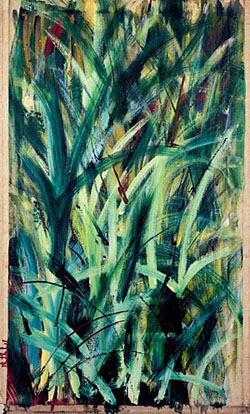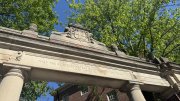The charismatic, maverick field anthropologist Patrick Tracy Lowell Putnam ’25 moved to what was then the Belgian Congo in the 1930s to study the Mbuti Pygmies. On a visit back to the United States, he met New York artist Anne Eisner, who was seduced by his tales of a primitive people living in an exquisite tropical forest, fell in love with him, and bought a one-way ticket to Africa in 1946, leaving her promising career in Manhattan to join him at Camp Putnama sort of dude ranch with a guesthouse on the Epulu River at the edge of the Ituri rainforest.
 |
| Anne Eisner, circa 1941. The photograph, in the Houghton Library, is possibly by Aaron Siskind. |
| By permission of the Houghton Librrary, Harvard University, 94M-11 |
“Eisner was an eccentric in the colonial context, creating a role that fewinside or outside the colonial hierarchycould comprehend,” writes Christie McDonald in a new book she edited, Images of Congo: Anne Eisner’s Art and Ethnography, 1946-1958 (5 Continents Editions, $39). “She was the first white woman to spend extended periods of time in Mbuti Pygmy camps, where they hunted and she painted; she transcribed 200 Pygmy legends; and she wrote extensive ethnographic notes, taking up where Putnamwhom Eisner married in 1948left off. The people of the area showed their confidence in Eisner by asking her to care for three orphaned Pygmy babies whom she brought up during their early life within a wide network of ‘mothers.’”
McDonald is Smith professor of French language and literature and chair of the Department of Romance Languages and Literatures. She is also Eisner’s niece, and the papers of the painter-ethnographer came to her in the mid 1980s. She put them in order and gave the archive, including 70 drawings and many photographs, to Houghton Library, which already had Patrick Putnam’s papers. She also called together colleagues in several disciplines for a workshop in 2002 to discuss Eisner’s work. Among the contributors to Images of Congo, which grew out of this collaboration, are Suzanne Preston Blier, Clowes professor of fine arts and professor of African and African American studies; F. Abiola Irele, who teaches in that department and in McDonald’s; Kay Kaufman Shelemay, Watts professor of music and a member of the African and African American studies department; and six others from outside Harvard.
Anthropologist Colin Turnbull, who spent a total of seven months at Camp Putnam in 1951 and 1954, made the Pygmies famous in his very popular book The Forest People (1961), portraying them as leading a life of freedom, equality, and goodness in blessed isolation from the farmer villagers and everyone else around them. Eisner did not share his view of reality, finding the Pygmies and their neighbors much less polarized. Although Turnbull relied on Eisner for access to her beloved Pygmies, and with her permission used her ethnographic notes, he barely mentions her name in his writing. Indeed, it was in part because Eisner had been left out of the history of the area that McDonald was moved to write her back into it. “The fact that Anne Eisner recorded her experience in the Congo rainforest not only in words, but in the symbolic mode of art,” she writes, “…lends her work a special significance for the study of culture, which ultimately rests on the capacity for understanding.”
All of the paintings below are oil on canvas; all are in private collections.
Paintings courtesy of Christie McDonald
 |
| Mother with Child II (1957) |
 |
| The Women (1956) |
 |
| Patrick Putnam (1945) He died in 1953, after which Eisner attempted to run Camp Putnam by herself. Eisner broke her hip in 1958 and left Africa for the United States and an operation. She never returned, but continum ed to paint her rainforest experiences from memory. She died of cancer in New York City in 1967 at 56. |
 |
| Ituri Forest IV (1960) |





